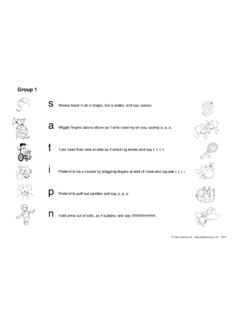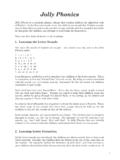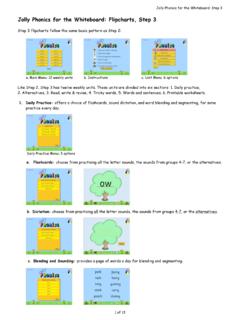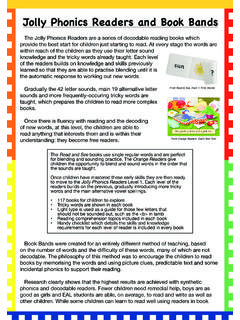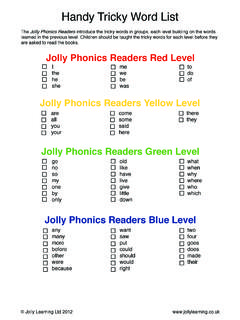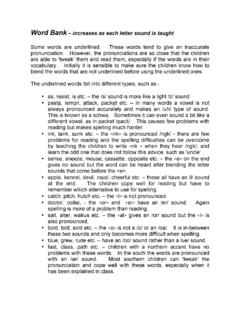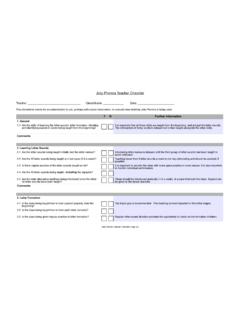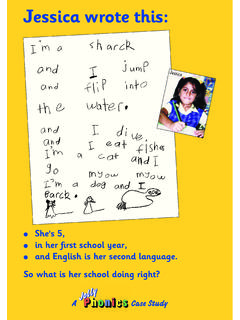Transcription of Parent / Teacher Guide - Amazon Web Services
1 11 Parent / Teacher Guide &&23 There are essentially two stages to literacy learning:Phonics - giving the basic ability to read and writeGrammar - giving the broader skills to be able to communicate wellJolly Phonics teaches both stages thoroughly and enjoyably through the primary/elementary years at school. In the first stage the letter sounds are taught in a fun, multisensory way. Children learn how to use the letter sounds to read and write the second, grammar stage, the structure of the language is taught. This includes parts of speech, spelling, punctuation and more. Children learn how to express themselves accurately and Guide provides advice for parents and teachers. It explains the principles behind Jolly Phonics, which enable the excellent the end of this Guide are descriptions of the Jolly Phonics materials. Those marked with a * are especially suitable for use at five basic skills for reading and writing are:1.
2 Learning the letter sounds2. Learning letter formation3. Blending4. Identifying sounds in words5. Spelling the tricky wordsPhonics StageJolly Phonics uses the synthetic phonics method, which means that the letter sounds are taught first, on their own, and children are then taught to blend sounds together to say ( synthesise ) the sound is taught with an action, which helps children remember the letter(s) that represent it. For the sound s for instance, they hear a story about going for a walk and suddenly seeing a snake. They weave their hands, pretending to be that snake, saying sss. In this way, one letter sound can be taught each day. As a child becomes more confident, the actions are no longer necessary. There is a list of all of the letter sounds and their corresponding actions on page 8 of this should learn each letter by its sound, not its name.
3 For example, the letter a should be called a (as in ant) not ai (as in aim). Similarly, the letter n should be n (as in net), not en. This will help in blending. The names of each letter will be taught later. The letters have not been introduced in alphabetical order. The first group (s, a, t, i, p, n) has been chosen because they make more simple three-letter words than any other six letters. The letters b and d are introduced in different groups to avoid that have more than one way of being written are initially taught in one form only. For example, the sound ai (rain) is taught first, and then alternatives a-e (gate) and ay (day) follow later. Examples can be found in the Jolly Phonics Word Learning the letter soundsIn Jolly Phonics the 42 main sounds of English are taught, not just the alphabet. The sounds are in seven groups.
4 Some sounds are written with two letters, such as ee and or. These are called digraphs. Both oo and th can make two different sounds, as in book and moon, that and three. To distinguish between these two sounds, the digraph is represented in two forms. This is shown below. s, a, t, i, p, n c k, e, h, r, m, d g, o, u, l, f, b ai, j, oa, ie, ee, or z, w, ng, v, oo, oo y, x, ch, sh, th, th qu, ou, oi, ue, er, arGroup 1:Group 2:Group 3:Group 4:Group 5:Group 6:Group 7:452. Learning letter formationIt is very important that a child holds their pencil in the correct grip is the same for both left- and right-handed pencil should be held in the tripod grip between the thumb and first two fingers. If a child s hold starts incorrectly, it is very difficult to correct later child needs to form each letter the correct way.
5 The letter c is introduced in the early stages as this forms the basic shape of some other letters, such as d. Particular problems to look for are: the o (the pencil stroke must be anticlockwise, not clockwise), d (the pencil starts in the middle, not the top), there must be an initial downstroke on letters such as m and Jolly Phonics DVD, My First Letter Sounds, Jolly Stories and Finger Phonics books show the correct formation of each letter. A good Guide is to remember that no letter starts on the Phonics offers the option of two typefaces, precursive, preferred in the UK, and print, preferred in North America. While print looks more like everyday printed letters, precursive eases the transfer to joined-up (cursive) writing with the exit strokes on some of the letters. Joined-up writing improves the fluency of writing, and also the spelling, as words are remembered more easily when written in one continuous BlendingBlending is the process of saying the individual sounds in a word and then running them together to make the word.
6 For example, sounding out d-o-g and making dog. It is a technique every child will need to learn, and it improves with practice. To start with, you should sound out the word and see if a child can hear it, giving the answer if necessary. Some children take longer than others to hear this. The sounds must be said quickly to hear the word. Try little and often with words like b-u-s, t-o-p, c-a-t and h-e-n. It is easier if the first sound is said slightly louder. There are lists of suitable words in The Phonics Handbook and the Jolly Phonics Word that some sounds (digraphs) are represented by two letters, such as sh. Children should sound out the digraph (sh), not the individual letters (s-h). With practice they will be able to blend the digraph as one sound in a word. So, a word like rain should be sounded out r-ai-n, and feet as f-ee-t.
7 This is difficult to begin with and takes practice. The Jolly Phonics Regular Word Blending Cards can be used in class to improve this will find it helpful to be able to distinguish between a blend (such as st) and a digraph (such as sh). In a blend the two sounds, s and t can each be heard. In a digraph this is not so. Compare mishap (where both the s and h are sounded) and midship (which has the quite separate sh sound). When sounding out a blend, encourage children to say the two sounds as one unit, so fl-a-g not f-l-a-g. This will lead to greater fluency when words in English have an irregular spelling and cannot be read by blending, such as said, was and one. Many of these are common words. The irregular parts have to be remembered. These are called the tricky words .67 The easiest way to know how to spell a word is to listen for the sounds in that word.
8 This is also called segmenting and is the reverse of by having your child listen for the first sound in a word. Games like I-Spy are ideal for this. Next try listening for the end sounds, as the middle sound of a word is the hardest to with simple three-letter words such as cat or hot. A good idea is to say a word and tap out the sounds. Three taps means three sounds. Say each sound as you tap. Take care with digraphs. The word fish, for example, has four letters but only three sounds, games, poems and the Jolly Songs also help tune the ears to the sounds in words. Other games to play are:a) Add a sound: what do I get if I add a p to the beginning of ink? Answer: pink. Other examples are m-ice, b-us, ) Take away a sound: what do I get if I take away p from pink? Answer: ink. Other examples as above, and f-lap, s-lip, c-rib, d-rag, p-ant, m-end, s-top, b-end, s-t-rip, Identifying sounds in words5.
9 Spelling the tricky wordsThere are different ways to learn words with irregular or tricky spellings:1) Look, Cover, Write and Check. Look at the word to see which bit is tricky. Ask the child to try writing the word in the air saying the letters. Cover the word over and see if the child can write it correctly. Check to make ) Say it as it sounds. Say the word so each sound is heard. For example, the word was is said as wass , to rhyme with mass, the word Monday is said as M-on-day .3) Mnemonics. The initial letter of each word in a saying gives the correct spelling of a word. For example, laugh - Laugh At Ugly Goat s ) Using joined-up (cursive) writing also improves StorybooksOnce a child has begun to learn the letter sounds they will be able to pick them out in words. They should then move on to working out whole words through blending. It is easier if reading begins with storybooks that use simple regular words.
10 Such words are easily read from the code of writing and so are described as decodable storybooks . The Jolly Phonics Readers are an example of such there is fluency in reading, the most important skills for a child will be comprehension and the understanding of more words. This can be developed by asking a child questions about a story they have just s achievement in the Phonics stageIndependent studies find that, after one year s teaching, children taught with Jolly Phonics have an average reading age around 12 months ahead of their actual age. For spelling the gain is usually slightly more. In addition, it is typical for all children to do well, whatever their social background, and whether English is their first language or not, with boys doing as well as Phonics has been developed by Sue Lloyd and Sara Wernham, who were primary/elementary school teachers at Woods Loke Primary School in Lowestoft, England.
